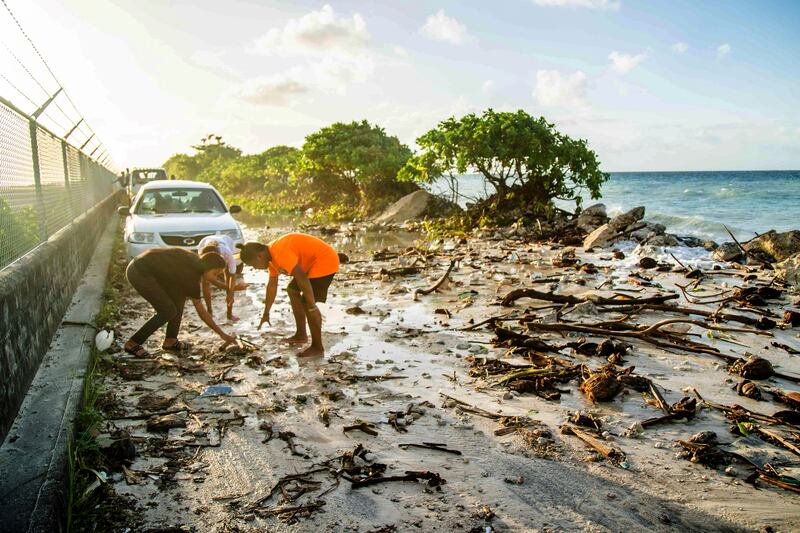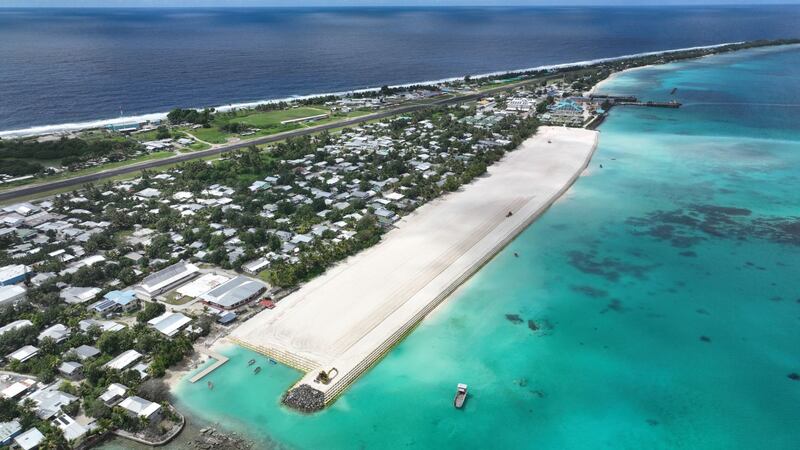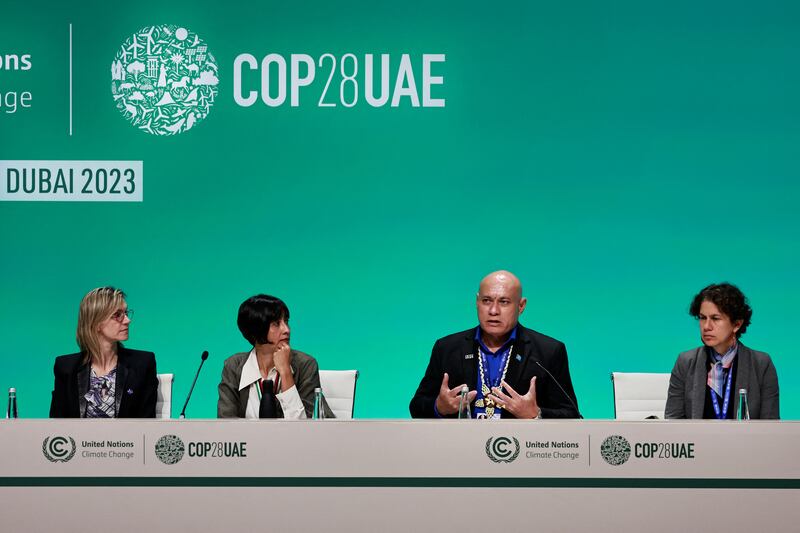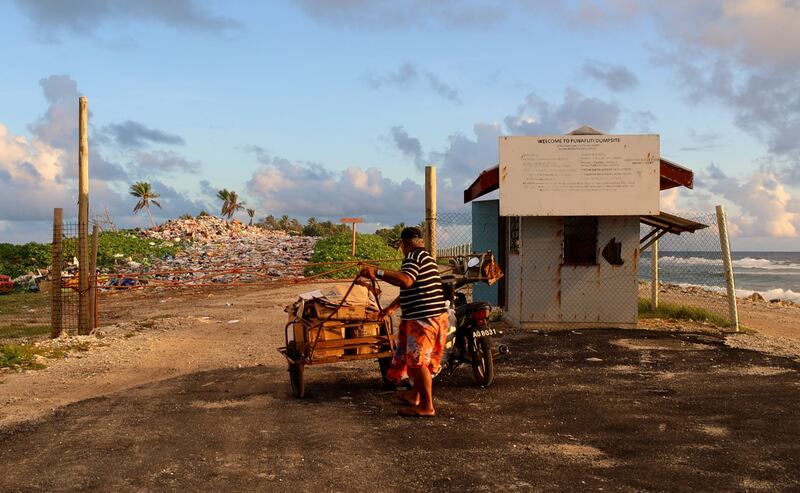For an attention-grabbing speech to the 2022 U.N. climate conference, a Tuvalu cabinet minister stood on one of the atoll nation’s smallest islands and predicted it could be the first to be submerged by rising seas.
The filament of land, known as Te Afualiku, however has more than tripled in area over the past century, geomorphological research shows. The entire land area of Tuvalu – a two-hour flight northeast of Fiji – increased by 2.9% over four decades despite sea levels around it rising twice as fast as the global average.
The increase resulted from land growth outpacing erosion on nearly all of its islands. The findings are part of a dataset of more than 1,100 coral reef islands in the Pacific and Indian Oceans that shows most of them have kept pace with sea-level rise – likely due to the intrinsic ability of reefs to build the islands that sit on them.
The body of research runs counter to a fatalistic narrative about small island nations. Popularized by media coverage, some scientific modeling based on the most pessimistic assumptions, and at times by island leaders in their efforts to galvanize donors, it voyeuristically portrays the low-lying atolls as doomed to disappear within decades and their people as inevitable and helpless climate refugees.
“In a hundred years there will still be islands in all these countries and people living on them. But the configuration of those islands is going to be looking different to what it currently is,” Paul Kench, an expert on changes in tropical coastal environments, told BenarNews.

Kench said his research shows there is no correlation between sea level rise – about 24 centimeters (9.4 inches) since 1880 – and changes in reef islands. To track the changes it uses satellite imagery as well as geological markers left by reef islands as they gradually move or alter in size.
About a third of the islands studied by Kench and other scientists decreased in area over different timeframes that range from a decade to more than a century. They were predominantly uninhabited and small, from 0.1 to 1.0 square kilometers (up to 0.4 square miles) in area and their erosion or movement was in keeping with natural change in reefs.
Despite the ability to adapt, atolls and the hundreds of thousands of people who live on them still face significant threats from a hotter planet.
It’s uncertain whether they can continue to keep up with sea-level rise, which has accelerated in recent decades.
Depending on what scenario unfolds for the carbon emissions that drive higher global temperatures, the ability of coral reefs to produce the sediments that underpin island building will be impaired or collapse – the latter still, some scientists say, an unlikely eventuality.
Deeper water over reefs means stronger waves and also a higher likelihood of events where storm surges wash over the low-lying atolls and inundate the urban centers that have filled slivers of land such as already flood-prone Majuro in the Marshall Islands and Fogafale in Tuvalu.
Governments of atoll nations increasingly see land reclamation and other engineering as the answers to projected sea-level rise.
At the last U.N. climate conference, in December, the Marshall Islands announced it would cost U.S. $35 billion to raise the height of all its atolls.
“We call it our survival plan,” said John Silk, a Marshall Islands politician.
“The financial implications of adapting to climate change are immense. We are looking at expenses in the billions to safeguard our homes, our culture and our future,” he said, according to a video of the climate conference presentation.
“The plan requires a robust climate finance strategy and the solidarity of the international community. We urge developed nations to join us in this endeavor.”

The Marshall Islands, home to about 40,000 people,says it should make decisions between 2040 and 2050 on which islands to protect, based on what data shows is happening to sea level, and consolidate infrastructure and social services on.
It would carry out island engineering between 2050 and 2070 to protect against a future sea-level rise of two meters (6.56 feet). One scenario is to move the people on Majuro and Ebeye atolls – 70% of the population – to different raised-up islands.
Last month, Tuvalu Finance Minister Seve Paeniu told BenarNews the country was seeking $1.3 billion for land reclamation that would create a long-lasting refuge for the country’s 10,000 people. The money would go into doubling the size of the most populated island, Fogafale, by reclaiming 3.6 square kilometers (1.4 square miles) from the lagoon and linking Fogafale to two smaller islets.
Contingent on financing, the first phase could start in 2025 and would involve moving the airport runway that dominates the center of the island, he said.
Tuvalu’s plans for Fogafale also double as a solution to some of the problems that stem from its small land area and urbanization. The relocated runway, for example, is envisaged as a rainwater catchment that could ease the island’s persistent shortages of fresh water.
The plan forecasts that half of Fogafale will be flooded at high tide by 2050 and nearly all of the island by 2100. Its assumptions are based on the most pessimistic but not inevitable scenario for emissions and related sea-level rise developed by the U.N.’s Intergovernmental Panel on Climate Change.
“If you think about it from the perspective of how do I best safeguard my home and you’ve got one shot to do it, I can get behind engineering for the more extreme variable,” said Alex Wegmann, a marine scientist at The Nature Conservancy.
“Because it could happen or something close to it could happen and you don’t want to have a once in a generation investment not be enough,” he said.

Wegmann works on the rehabilitation of Palmyra Atoll, a remote reef in the Pacific without permanent inhabitants that was significantly altered by the U.S. military during World War II. Land reclamation, such as that proposed by Tuvalu, also runs the risk that the atoll loses its ability to adapt naturally, he said.
Largely left alone since the end of the war, Palmyra has rebounded into an abundantly rich marine world and become an example of how an atoll environment can thrive. It is also a site for long-term conservation experimentation.
Since 2019, conservationists have been injecting herbicide into coconut palms to kill them and make more space for native vegetation that seabirds prefer to roost in.
It doesn’t mean island nations should abandon their copra–dried coconut meat–industries. The idea is that supporting the seabird population will result in more pooped out nutrients for the reef, underpinning its resilience.
“What we’re doing on Palmyra is hopefully going to be informative to atolls but we don’t envisage it as a carbon copy scenario because of the uniqueness of it,” Wegmann said.
In December, 10 scientists, including Kench and Wegmann, put their names to a scientific journal opinion piece that criticized the prevailing pessimism about atolls. They called for more research into measures – in parallel to the international efforts to reduce planet-warming emissions – to keep reefs healthy.
In interviews, some of the co-authors said land reclamation was part of the arsenal but shouldn’t be seen as the only option.
“Climate change, ocean warming, marine heatwaves, they’re all jeopardizing coral reefs but what’s tipping the scales between recovery and collapse is in most cases local factors,” said Sebastian Steibl, a conservation biologist at the University of Auckland.
“Reefs that are healthy, they can rebound and recover from these marine heatwaves. But if on top of that we also get sewage release, we get dredging, we get destructive reef practices, these are the corals that really collapse under these marine heatwaves,” he said.

Arthur Webb, the UNDP’s technical adviser on Tuvalu’s land reclamation plan, rejects the idea that natural island building and its uncertainties is a realistic strategy for populated atolls.
Storms and cyclones that can dump huge quantities of coral rubble on reefs and islands are known to be part of the island-building process but are untenable for communities, he said.
The land reclamation plan for Fogafale, he said, “is an engineering solution and will mostly replace natural processes – no apologies.”
“It’s a viable solution to a problem of immense magnitude to the people of Tuvalu. But crucially it is 100% commensurate with the scale of the problem science tells us they face,” Webb said.
It will provide a “reliable, stable, safe platform that will allow reasonably safe living for a known time horizon,” he said. “Nothing else comes close.”
Among the significant uncertainties for atoll nations, according to the Marshall Islands’ plan, are lack of understanding how reefs will respond to continuing human-driven changes in the climate and what interventions work.
“Not much is known about adaptation on atolls because there has been little investment in research,” it said. “Pilot studies are needed, for example, to identify whether nature-based measures will be able to keep pace with an accelerating rate of sea level rise.”
Kench said he was surprised by his joint initial research in about 2010 of some 30 reef islands that showed them growing in size. The findings were criticized, he said, so the research was expanded.
“I show people what the islands are doing. People don’t like that message quite often. And then they say what I say is controversial,” he said. “Because it cuts across what an island government might be wanting internationally to portray themselves as.”
The data, he said, should become the basis for predictive tools that help atoll nations plan amid sea-level rise.
“We would never suggest this isn’t challenging for island communities, but if you stop and look at how islands are changing, that puts you in a much more powerful position to make decisions,” he said.
